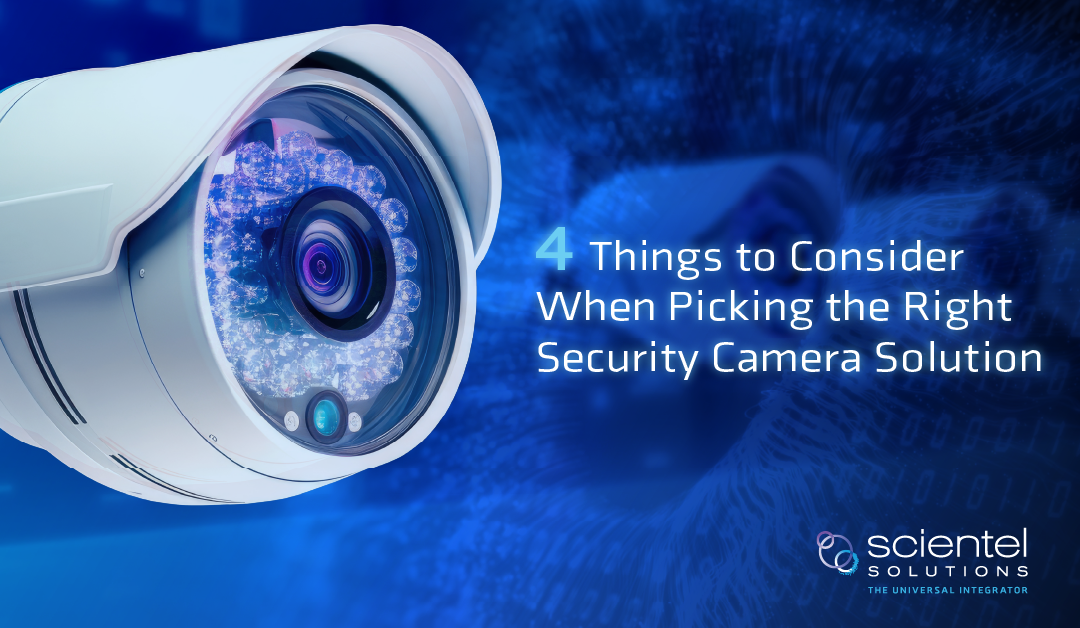by Daniel Bruno, Business Unit Manager – Security
Finding the right video security solution that protects assets, staff, and clients is crucial to maintaining an organization’s daily operations. However, navigating the landscape of security cameras can be overwhelming. Video technology has evolved significantly over the past 20 years in both hardware and software. These enhancements in machinery have produced advanced camera capabilities that include HD/4k resolution, infrared sensors, AI processors, facial recognition, PTZ functionality, and much more. With today’s modern cameras and their many possible integrations, users must carefully consider what features will adequately protect their facility. Here are four things to take into consideration when picking a security camera solution.
1.) Basic Camera Functionality
Understanding facility vulnerabilities and how much surveillance is required to secure them varies by industry. For example, a car dealership and a correctional facility will have two very different needs regarding the level of situational awareness. When looking at various camera options, knowing the type of detection, recognition, and identification integrations required to protect what’s most important is essential for deterring potential dangers.
Detection is a fundamental security camera feature. It helps security personnel identify and respond to potential threats. From motion detection to intrusion detection, the possibilities are vast. Working with security personnel is a great way to determine what visual aspects are most important to securing the facility and will be essential when making this decision.
Though recognition may seem similar to identification, it takes a broader approach when identifying individuals and objects. Recognition categorizes things, events, and people without necessarily identifying specific identities. Organizations with heavy foot traffic in their facilities often install cameras with recognition capabilities. This security camera solution is usually integrated with access control technology to offer a more complete situational awareness solution.
On the more advanced side, identification involves recognizing and verifying the identity of individuals or objects. Cameras specializing in biometrics, object classification, or facial identification are good examples of the identification capabilities you can incorporate into your solution. Paying close attention to the safety and security risks other establishments experience in the same industry can help determine the type of identification features organizations should implement.
2.) Scene Requirements
To ensure that security cameras effectively capture information, factors such as camera placement, positioning, and configuration play a large role in what kinds of cameras one should purchase. Security personnel may find themselves in an environment that benefits most from cameras with PTZ (pan, tilt, and zoom) capabilities to increase their field of view. Power source and network connectivity can change from facility to facility and is another factor to consider. Taking the time to survey where to position cameras, how their data is stored, and how they are powered will make the camera selection process much smoother.
The environment also plays a vital role in what type of camera and supporting equipment a person should choose. Every area presents obstacles that can inhibit an optimized surveillance experience. From indoor locations to outdoor, high-traffic areas to poorly lit sites, learning what cameras respond well to one’s specific environment is a pivotal step in the selection process.
3.) Camera Visibility
After narrowing down the specific scene requirements, determining camera visibility is the next step in selecting a new security solution. One can broadly place camera visibility into three categories: covert, visible, and discrete.
Covert cameras, or hidden cameras, are intentionally concealed to provide unnoticeable detection. They allow security personnel to monitor candid behavior, while also serving as a great way to catch evidence without alerting the assailant of their presence. However, covert cameras may raise legal concerns when considering an organization’s industry. In addition, covert cameras are usually small and may have a limited field of view.
Visible cameras, often referred to as deterrent cameras, are easily noticeable and often include prominent housing. These types of cameras can provide a sense of protection and security to occupants, often making potential assailants wary. However, visible cameras can be vulnerable to vandalism and tampering.
Discrete cameras are a blend of both covert and visible cameras. They work to strike a balance between being less conspicuous than visible designs and more noticeable than covert designs. Discrete cameras work to capture evidence without tipping off wrongdoers while still discouraging possible criminals. Though discrete cameras may seem like the best of both worlds, they still run the same problem of being targets of vandalism.
4.) Consult An Expert
With all the possibilities of modern camera technology, determining the best solution can be highly time-consuming. If organizations are looking for a new camera solution, it’s best to consult an experienced security engineer. A physical security engineer can help organizations make the right security decisions exclusive to their facility. If the engineer is truly worth their weight in salt, they can also help reduce operational costs. Having an expert handle the challenge of one’s security camera solutions ensures the success and functionality of the solution.

